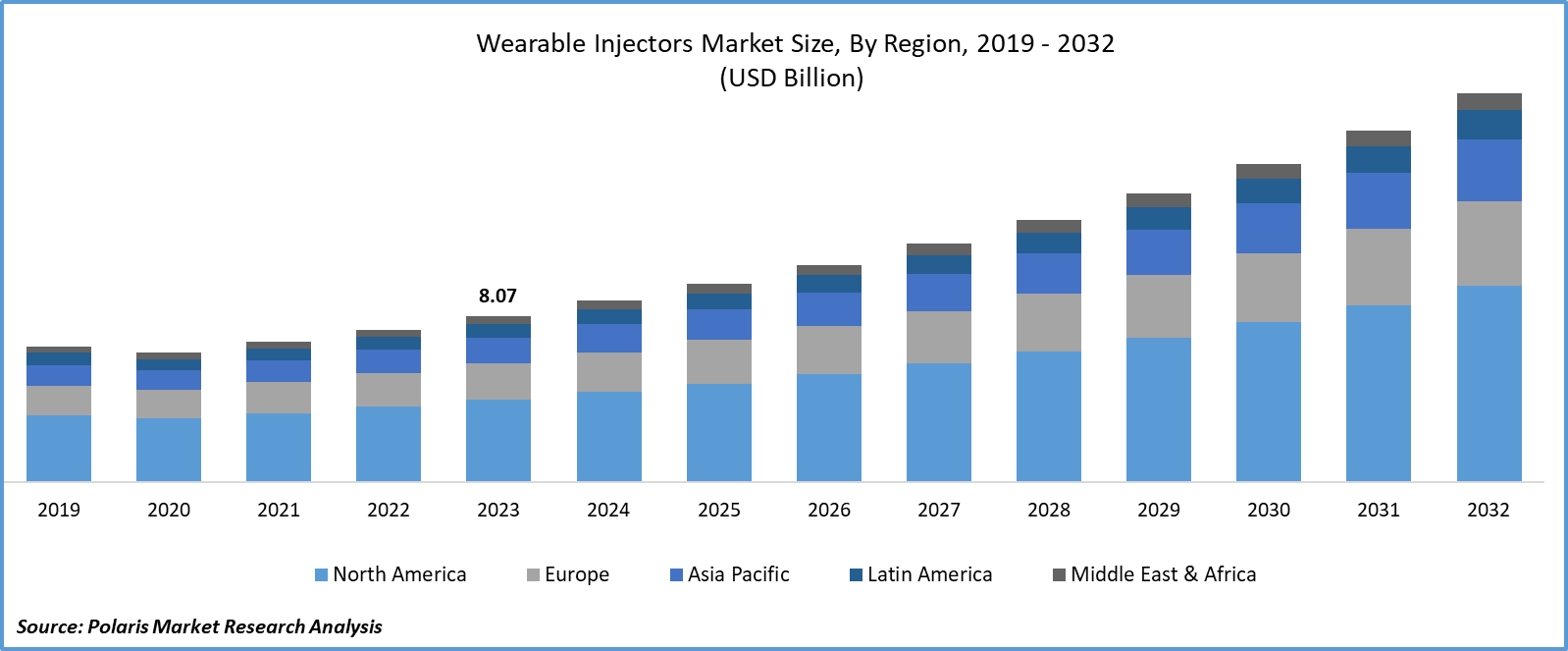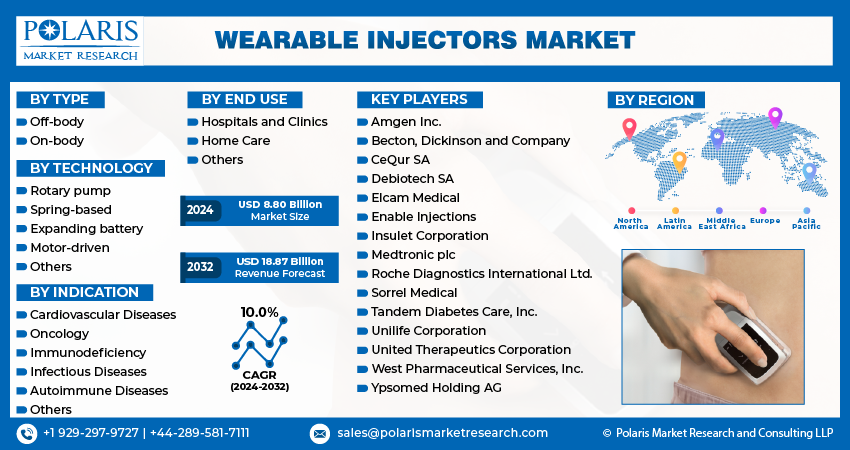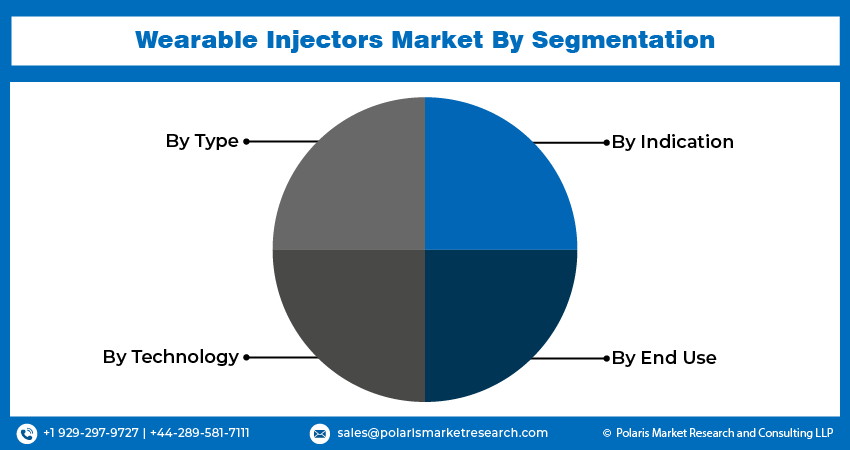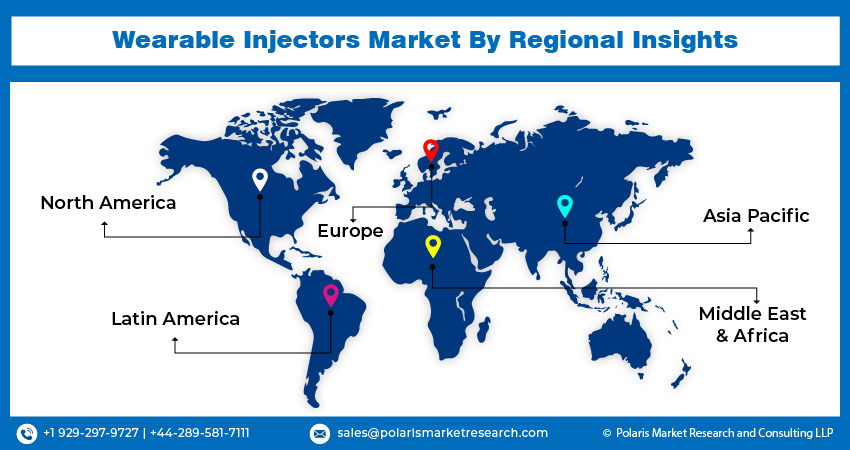
Wearable Injectors Market Share, Size, Trends, Industry Analysis Report
By Type (Off-body, On-body); By Technology; By Indication; By End Use; By Region; Segment Forecast, 2024- 2032
- Published Date:Apr-2024
- Pages: 115
- Format: PDF
- Report ID: PM4842
- Base Year: 2023
- Historical Data: 2019-2022
Report Outlook
Wearable Injectors Market size was valued at USD 8.07 billion in 2023.
The market is anticipated to grow from USD 8.80 billion in 2024 to USD 18.87 billion by 2032, exhibiting the CAGR of 10.0% during the forecast period.
Market Introduction
The wearable injectors market is growing due to a shift towards home-based healthcare. Advanced medical technology and patient-centric care drive the trend of managing chronic conditions outside traditional healthcare settings. Wearable injectors enable patients to self-administer medications at home, offering convenience and flexibility. These devices provide continuous drug delivery and precise dosage administration, ensuring optimal therapeutic outcomes. Home-based healthcare enhances patient autonomy, reduces healthcare costs, and alleviates the burden on healthcare facilities. As a result, the demand for wearable injectors is rising, as healthcare systems increasingly prioritize decentralized care models.

To Understand More About this Research:Request a Free Sample Report
In addition, companies operating in the market are entering partnerships and collaborations to strengthen market presence.
For instance, in February 2021, Phillips-Medisize partnered with Subcuject to introduce an innovative wearable bolus injector to the market. The novel Wearable Osmotic Bolus Injector is crafted to offer a cost-effective, user-friendly solution, preloaded for single-use applications.
Advancements in drug delivery technologies are driving the wearable injectors market. These innovations offer precise and controlled medication administration, improving treatment efficacy and patient outcomes. Wearable injectors provide the convenience of self-administration, empowering patients to manage their treatment regimens effectively. With compact designs and user-friendly features like variable dosing options and connectivity with digital health platforms, these devices enhance patient experience. Additionally, the integration of smart sensors enables real-time monitoring of drug delivery.
Industry Growth Drivers
Increasing Prevalence of Chronic Diseases is Projected to Spur the Product Demand
The wearable injectors market is growing due to the rising prevalence of chronic diseases globally. Conditions like diabetes, autoimmune disorders, cardiovascular diseases, and cancer require frequent medication administration, boosting the demand for convenient drug delivery solutions. Wearable injectors allow patients to self-administer medications at home, reducing hospital visits and improving treatment adherence. Moreover, the aging population and escalating healthcare expenses drive the adoption of wearable injectors for efficient chronic disease management. Technological advancements in wearable injector devices, including enhanced user interfaces and connectivity features, further enhance patient experience and treatment outcomes.
Growing Aging Population is Expected to Drive Wearable Injectors Market Growth
The wearable injectors market experiences significant growth due to the expanding aging population. With age-related health concerns rising, there's a surge in chronic conditions necessitating regular medication. Wearable injectors offer a convenient solution, particularly for elderly individuals facing challenges in self-administering injections. These devices ensure precise dosage delivery and enable continuous drug administration, crucial for managing conditions like diabetes and cardiovascular diseases prevalent among aging individuals. Moreover, wearable injectors enhance patient compliance and treatment adherence by providing a comfortable and less invasive option for injections. This improved compliance leads to better disease management and health outcomes for the aging population, thus driving the demand for wearable injectors in healthcare.

Industry Challenges
High Cost of Development is Likely to Impede the Market Growth
The wearable injectors market encounters limitations due to the high cost of development. Research and development expenses, including technology innovation, regulatory compliance, and clinical trials, are substantial. Ensuring device safety and effectiveness requires extensive testing, adding to costs. Manufacturing entails specialized equipment and materials, further driving expenses. These high development costs pose barriers to market entry for new players and limit innovation among existing manufacturers.
Report Segmentation
The wearable injectors market analysis is primarily segmented based on type, technology, indication, end use, and region.
|
By Type |
By Technology |
By Indication |
By End Use |
By Region |
|
|
|
|
|
To Understand the Scope of this Report:Speak to Analyst
By Type Analysis
On-Body Segment Held Significant Revenue Share in 2023
The on-body segment held significant revenue share in 2023 due to its enhanced convenience, ease of use, and continuous drug delivery features. Users appreciate the simplicity of administering medication directly without additional devices, making it accessible to a wider patient demographic. Moreover, its customizable design allows for personalized treatment regimens, further driving adoption. As healthcare providers and patients increasingly favor these devices for their convenience and efficacy in managing chronic conditions, the on-body type segment continues to experience significant growth.
By Technology Analysis
Spring-Based Segment Held Significant Revenue Share in 2023
The spring-based segment held significant revenue share in 2023. It ensures precise and consistent drug delivery, guaranteeing accuracy in medication administration. Additionally, its compact design offers comfortable and discreet wear for patients. Moreover, these devices are user-friendly, requiring minimal effort for operation, enhancing patient compliance. Furthermore, they are cost-effective compared to alternative technologies, making them attractive for healthcare providers and patients. Spring-based technology provides a proven track record of safety and efficacy in drug delivery, instilling confidence among healthcare professionals and patients.
By Indication Analysis
Oncology Segment Held Significant Revenue Share in 2023
The oncology held significant revenue share in 2023. The high disease burden associated with cancer necessitates frequent and prolonged treatment regimens. Wearable injectors offer convenience to cancer patients by enabling self-administration of medications at home, enhancing their quality of life. Moreover, these devices facilitate improved treatment adherence, leading to better outcomes for oncology patients. Significant investments in research and development have resulted in the development of tailored wearable injector technologies for oncology applications, further driving market growth in this segment.
By End Use Analysis
Hospitals and Clinics Segment Held Significant Revenue Share in 2023
The hospitals and clinics segment held significant revenue share in 2023 due to its clinical necessity, patient monitoring capabilities, treatment adherence benefits, workflow efficiency, and regulatory compliance advantages. These settings serve as primary locations for patient consultations and treatment, where healthcare professionals prescribe and administer medications using wearable injectors. Vital for managing acute conditions, these devices allow real-time patient monitoring, optimizing treatment outcomes. Wearable injectors also enhance medication adherence, crucial for patients with complex medical conditions requiring long-term regimens. Moreover, they streamline workflow processes, improving efficiency in busy clinical environments.

Regional Insights
Asia-Pacific Region is Expected to Experience Significant Growth During the Forecast Period
Asia-Pacific region is expected to experience significant growth during the forecast period. Increasing healthcare expenditure in countries like China, India, and Japan supports the adoption of advanced healthcare technologies. Additionally, the growing aging population in the region drives the prevalence of chronic diseases, boosting the demand for wearable injectors. Government initiatives aimed at improving healthcare infrastructure and promoting innovative healthcare solutions also contribute to market expansion. Moreover, increasing awareness and acceptance of wearable healthcare devices among patients drive the adoption of wearable injectors in the Asia-Pacific region.
North America dominated the global market in 2023 due to its advanced healthcare infrastructure, significant investments in medical technology, and robust ecosystem for innovation. The region benefits from stringent yet predictable regulatory frameworks, fostering confidence among manufacturers and healthcare providers. Rising chronic disease prevalence and patient demand for convenience further drive the adoption of wearable injectors. With well-equipped healthcare facilities and a strong healthcare system, North America is well-positioned to integrate wearable injector technologies into clinical practice.

Key Market Players & Competitive Insights
The wearable injectors market involves a diverse array of players, and the expected arrival of new contenders is poised to intensify rivalry. Established leaders continuously enhance their technologies to maintain a competitive advantage, emphasizing effectiveness, reliability, and safety. These firms prioritize strategic actions such as establishing collaborations, improving product portfolios, and participating in cooperative endeavors. Their aim is to outperform competitors within the field, securing a significant wearable injectors market share.
Some of the major players operating in the global wearable injectors market include:
- Amgen Inc.
- Becton, Dickinson and Company
- CeQur SA
- Debiotech SA
- Elcam Medical
- Enable Injections
- Insulet Corporation
- Medtronic plc
- Roche Diagnostics International Ltd.
- Sorrel Medical
- Tandem Diabetes Care, Inc.
- Unilife Corporation
- United Therapeutics Corporation
- West Pharmaceutical Services, Inc.
- Ypsomed Holding AG
Recent Developments
- In June 2023, Eitan Medical reported the accomplished sale and transfer of its wearable injectors division to LTS, a prominent pharmaceutical technology firm specializing in the development and production of advanced drug delivery solutions.
- In October 2023, Enable Injections announced FDA approval for its wearable injector, the Empaveli Injector. Specifically designed for adults managing paroxysmal nocturnal hemoglobinuria, this device enables hands-free drug delivery of up to 25 mL. It offers versatility for use in both home and clinic settings.
Report Coverage
The wearable injectors market report emphasizes on key regions across the globe to provide better understanding of the product to the users. Also, the report provides market insights into recent developments, trends and analyzes the technologies that are gaining traction around the globe. Furthermore, the report covers in-depth qualitative analysis pertaining to various paradigm shifts associated with the transformation of these solutions.
The report provides detailed analysis of the market while focusing on various key aspects such as competitive analysis, types, technologies, indications, end uses, and their futuristic growth opportunities.
Wearable Injectors Market Report Scope
|
Report Attributes |
Details |
|
Market size value in 2024 |
USD 8.80 billion |
|
Revenue forecast in 2032 |
USD 18.87 billion |
|
CAGR |
10.0% from 2024 – 2032 |
|
Base year |
2023 |
|
Historical data |
2019 – 2022 |
|
Forecast period |
2024 – 2032 |
|
Quantitative units |
Revenue in USD billion and CAGR from 2024 to 2032 |
|
Segments covered |
|
|
Regional scope |
|
|
Competitive Landscape |
|
|
Report Format |
|
|
Customization |
Report customization as per your requirements with respect to countries, region, and segmentation. |
FAQ's
key companies in Wearable Injectors Market are Amgen Inc., Becton, Dickinson and Company, CeQur SA, Medtronic plc, Roche Diagnostics International Ltd
Wearable Injectors Market exhibiting the CAGR of 10.0% during the forecast period.
The Wearable Injectors Market report covering key segments are type, technology, indication, end use, and region.
key driving factors in Wearable Injectors Market are Growing aging population
The global Wearable Injectors market size is expected to reach USD 18.87 billion by 2032
